
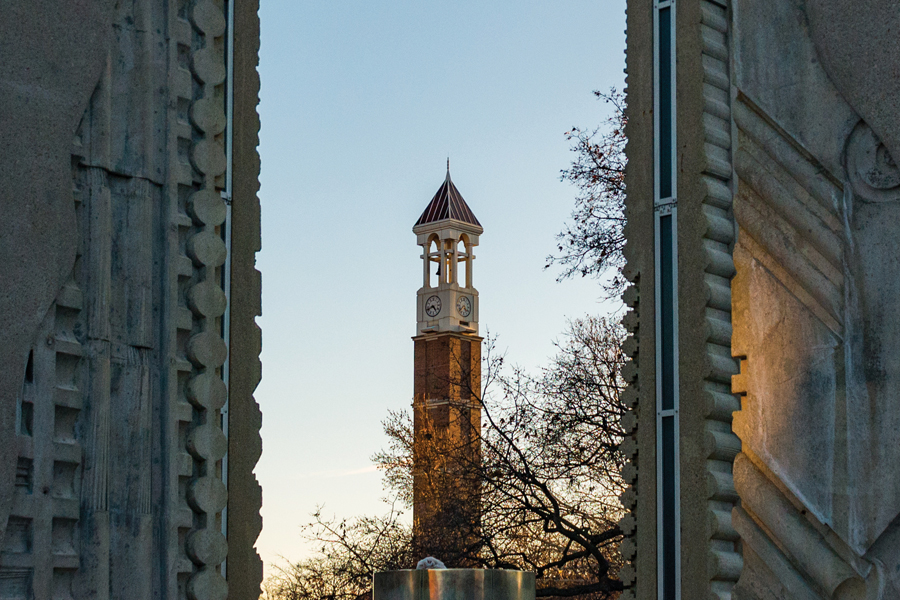

Mark Lundstrom
An introduction to this issue of FRONTIERS magazine by Interim Dean Mark Lundstrom.
10 minutes to read
I’m proud to say Purdue Engineering is front and center in the growing national initiative to create a thriving microelectronics ecosystem. Our research and workforce development leadership drew national attention and praise last month when U.S. Secretary of State Antony J. Blinken and Secretary of Commerce Gina Raimondo joined top Indiana government officials to visit Purdue and discuss the role of universities in addressing the nation’s semiconductor challenge. They toured our facilities, met with students, and participated in a fireside chat about universities and the CHIPS Act.
The event capped a highly productive several months in which our College of Engineering has collaborated with government, industry and academic partners to reach new heights in excellence at scale, elevating our research and workforce development capabilities to address critical national priorities. Purdue continues to rank among the most innovative schools in the nation, and our undergraduate and graduate programs continue to be highly ranked.
Fittingly, FRONTIERS magazine this fall highlights significant advances in areas crucial to our country’s defense and security and to global economic competitiveness. I invite you to learn about giant leaps to benefit the microelectronics industry and national security, develop hard AI and connect communities, and provide a launchpad for advanced manufacturing and digital transformation.
The first two sets of stories cover accomplishments to support the national security and technology pillar of Purdue’s Next Moves. First, we describe how we’re addressing the nation’s critical need for innovation and workforce development in semiconductors through research; manufacturing partnerships; internships; and a new comprehensive education, degrees and credentials program. Next, we share milestones for our rapidly-growing hypersonics and aerospace hubs, including plans for a high-speed propulsion laboratory for hypersonic testing, a $75-million research and testing alliance with Rolls-Royce, and the opening of a multimillion-dollar Saab advanced manufacturing plant.
In the third group of stories, you’ll read about our latest strides at the interface of virtual-physical engineering, involving a new institute to connect AI with the physical world, the beginnings of a “Hard Tech Corridor” in Indiana, and innovation to improve traffic safety in smart cities.
This issue concludes with stories on the burgeoning Discovery Park District at Purdue – a 400-acre launchpad where businesses of all sizes can access a business-minded university, global talent pipelines, and advanced R&D facilities to solve business problems. You’ll learn about plans for a new institute for pharmaceutical manufacturing, a Bayer space for agricultural innovation, a Wabash collaborative space, and a 6G “Lab To Life” real-world test bed.
We are proud to be in the vanguard, and we thank our talented and dedicated faculty, students, staff and partners for their invaluable contributions.

Alumni should send change-of-address notices to:
Dick and Sandy Dauch Alumni Center
403 West Wood Street
West Lafayette, IN 47907-2007
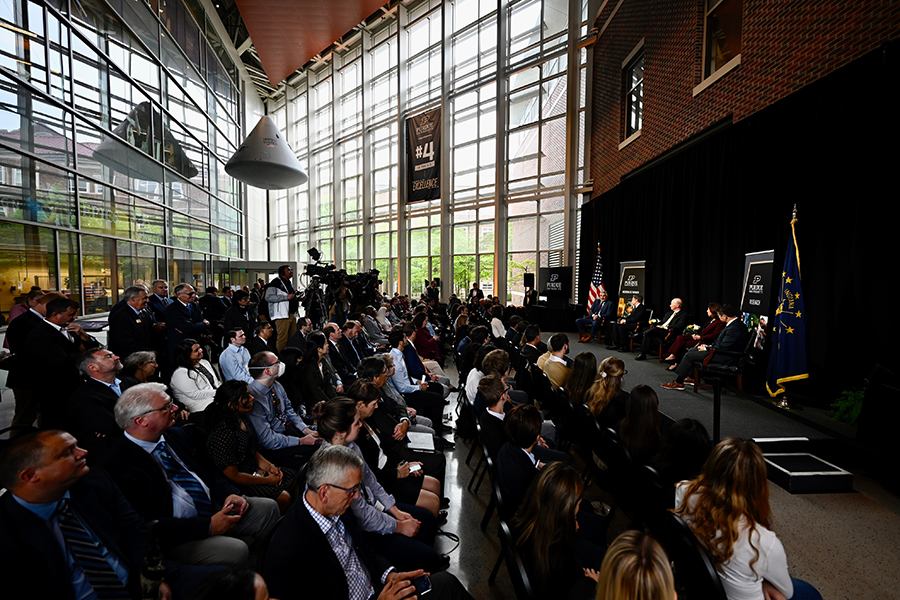

Gov. Holcomb, Sen. Young join Blinken and Raimondo in visiting Purdue's Nanotechnology Center as national CHIPS initiative kicks off
Secretaries of State, Commerce at Purdue to discuss efforts to build a U.S. microelectronics ecosystem.
(Photo credit: Purdue University | Tate Kirgiss )
10 minutes to read
Banner image: Purdue President Mitch Daniels hosted U.S. Secretary of State Antony J. Blinken, Secretary of Commerce Gina Raimondo, Sen. Todd Young (R-Ind.) and Indiana Gov. Eric J. Holcomb at the Neil Armstrong Hall of Engineering for a fireside chat that focused on building a semiconductor ecosystem.
U.S. Secretary of State Antony J. Blinken and Secretary of Commerce Gina Raimondo visited Purdue University on Sept. 13, 2022, to tour research facilities and meet students as they embark on their mission to bolster the U.S. semiconductor industry.
Sen. Todd Young (R-Ind.) and Indiana Gov. Eric J. Holcomb joined Blinken and Raimondo on a tour of Purdue’s Birck Nanotechnology Center, highlighting the leading-edge research and workforce development efforts at Purdue that can help the U.S. restore domestic semiconductor manufacturing and competitiveness abroad.
The tour included the Scifres Nanofabrication Laboratory, which has one of the world’s largest university cleanrooms. While at Purdue, the guests also were briefed on the university’s new suite of semiconductor degree programs, ranging from undergraduate through graduate study, and Purdue’s Scalable Asymmetric Lifecycle Engagement (SCALE), a preeminent U.S. program for semiconductor workforce development in the defense sector. Purdue President Mitch Daniels hosted the group.
“We understand the imperative for the United States to be a leader in semiconductors and microelectronics production and innovation,” Daniels said. “It’s through Purdue’s interdisciplinary credentials, degrees and training opportunities, and critical partnerships with industry and that we strive to make a difference and a sound contribution to this effort. We’re honored to show secretaries Blinken and Raimondo what we have done and what we have on the horizon.”
Speaking to the crowd at Birck, Raimondo announced that the Commerce Department’s National Institute of Standards and Technology signed a cooperative research and development agreement to develop and produce chips for nanotech and semiconductor devices. SkyWater Technology will manufacture the chips at an existing semiconductor foundry in Minnesota. This summer, Purdue announced partnerships with SkyWater to build a $1.8 billion fabrication facility in West Lafayette.
“Purdue’s cutting-edge research and workforce development programs are at the forefront of helping us shape the future of innovation in America’s semiconductor manufacturing industry. I’m excited to learn about the workforce pipelines Purdue is creating, including opportunities at all levels of the industry,” Raimondo said. “I’m excited to have met the students who are future leaders of America’s semiconductor industry. The graduates from these programs — from PhDs to associate degree holders — will be at the forefront of innovation as we revitalize American manufacturing.”
At Birck, the group was briefed on architecture/brain-inspired computing, heterogenous packaging, modeling and workforce development efforts that comprise the local, high-tech ecosystem at Purdue. Blinken and Raimondo spoke with Purdue students, who explained their innovation, research and progress in these areas.
Daniels then hosted the guests at the Neil Armstrong Hall of Engineering for a fireside chat that focused on building a semiconductor ecosystem to restore domestic manufacturing and competitiveness abroad.
Blinken later met with Purdue students at the Burton D. Morgan Center for Entrepreneurship to take their questions and discuss STEM careers and paid student programs at the Department of State. His visit coincided with the Industrial Roundtable job fair, among the largest student-run career events in the country, with more than 400 companies and 12,000 students attending annually.
“Indiana is home to world-renowned research and development universities like Purdue,” Holcomb said. “We have access to the necessary robust pool of highly skilled manufacturing workforce and a top-ranked business climate that makes Indiana a prime location for future-focused industries. Indiana seeks to be a leader in the United States and globally for microelectronics and semiconductor manufacturing. We firmly believe that the CHIPS for America program will best position our nation to get there.”
“The CHIPS and Science Act is the type of bipartisan economic and national security win that only comes along once in a generation,” Young said. “We’re grateful that secretaries Blinken and Raimondo came to see the work that is already being done in Indiana to ensure that Hoosier students and workers are prepared to answer the call to out-innovate and outcompete China. As the bill is implemented in coming months, it’s clear that all eyes are on Indiana.”
“To confront the challenges our nation faces today, we need people who understand the intersection of economics, diplomacy, emerging technology and the sciences. We find these people at places like Purdue, which bring together academia and the private sector to ensure that we can remain the world’s innovation leaders and standard setters,” Blinken said of the visit. “The groundbreaking work here and at institutions around the country is rooted in the recognition that foreign, economic and domestic policy are inextricably linked and that domestic competitiveness, national security and a strong middle class are mutually reinforcing.”
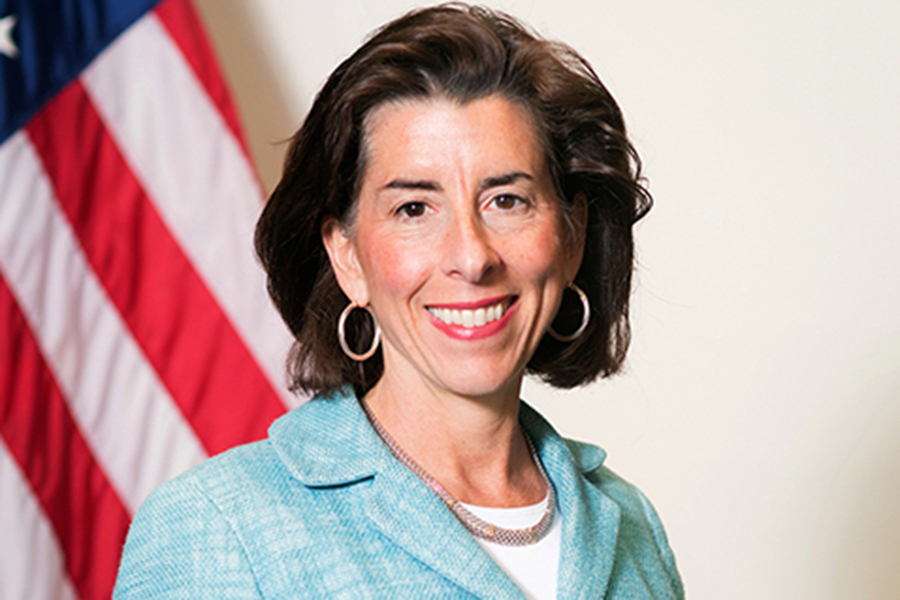
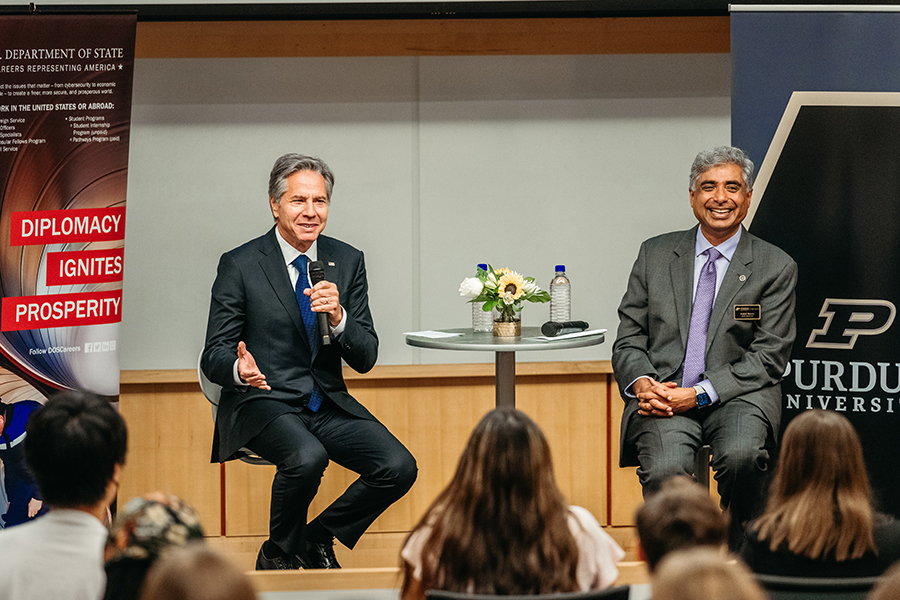
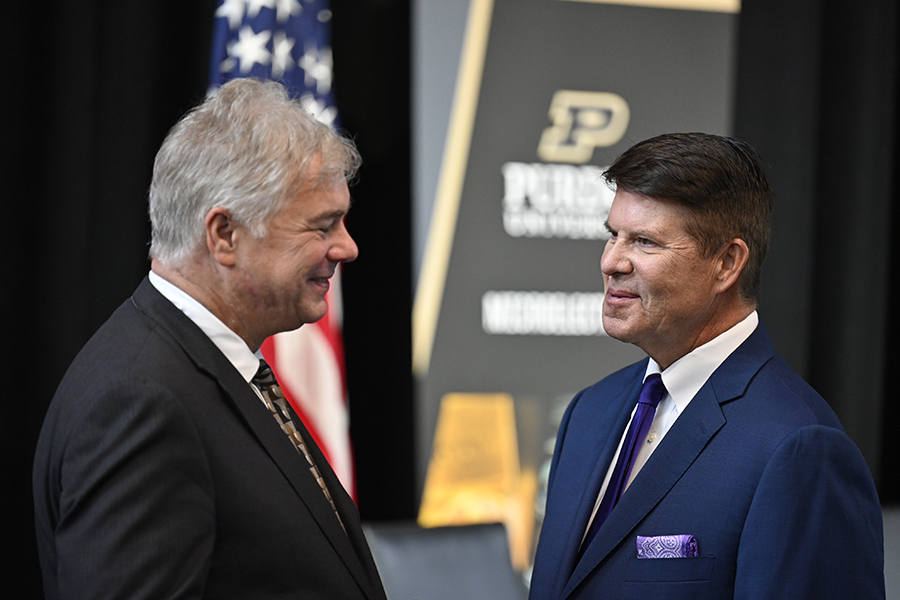
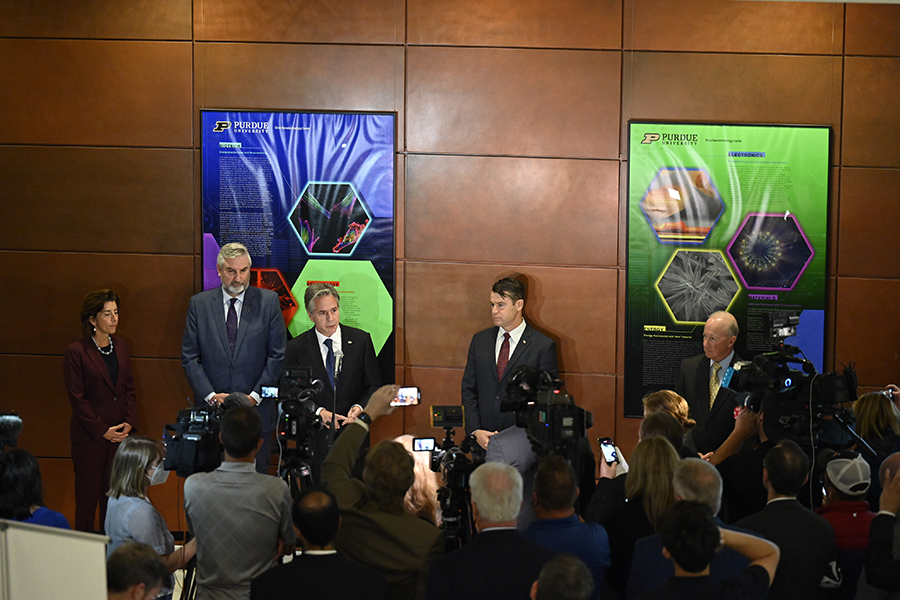
Skywater Technology chooses Discovery Park District for $1.8B semiconductor fabrication facility.
(Illustration credit: Purdue University)
10 minutes to read
Banner image: Conceptual drawing of SkyWater Technology manufacturing facility to be built in Discovery Park District at Purdue
By Steve Martin
The July 2022 announcement by SkyWater Technology that it plans to open a $1.8 billion state-of-the-art semiconductor manufacturing facility in the Discovery Park District at Purdue marks a huge step forward for the American semiconductor industry, Purdue’s thriving innovation district, and the university’s continued emergence as a principal driver of the Indiana economy.
SkyWater, which expects to create 750 new direct jobs within five years after it opens, joins the likes of Saab, Rolls-Royce, major facilities and partnerships in hypersonics, Schweitzer Engineering Laboratories, Wabash, MediaTek and others in the Discovery Park District at Purdue — one of the most attractive and innovative environments in the Midwest.
With this new investment from SkyWater, the funds needed to pay off the obligations to the 231 Purdue TIF district, created as part of the State Street project, will be in hand more than a decade in advance.
Doing its part to address the global semiconductor shortage has been a priority at Purdue. In May 2022, Purdue launched a comprehensive set of interdisciplinary degrees and credentials in semiconductors and microelectronics. The nation’s first large-scale, interdisciplinary Semiconductor Degrees Program (SDP), the suite of innovative Purdue degrees and credentials, will educate both graduate and undergraduate students, in residence and online, enabling a quick ramp-up of skilled talent.
In June 2022, Purdue began a partnership with MediaTek Inc., a leading global fabless chip designer, to open the company’s first semiconductor chip design center in the Midwest, to be housed in the Discovery Park District at Purdue.
The U.S. developed microchip technology in the 1950s, and its manufacturing output was 37 percent of the total global output in 1990. However, as manufacturing moved to East Asia — countries including China, Japan, South Korea and Taiwan — the U.S. global output of semiconductor manufacturing fell to 12 percent in 2021. The shift could lead to problems in the digital economy if the supply chain is disrupted.
As a solution, the Creating Helpful Incentives to Produce Semiconductors for America Act, or CHIPS Act, was signed into law on Aug. 9, 2022. It supports the nation’s research and development, manufacturing, and supply chain security of semiconductors.
Building the new 600,000-square-foot, state-of-the-art semiconductor manufacturing facility, which includes 100,000 square feet of cleanroom space, will depend on SkyWater receiving funds from the CHIPS Act, said Thomas Sonderman, president and CEO of SkyWater Technology. American jobs created will focus on research and design engineering, technology development, operations engineering, maintenance and technical support, and technicians.
“Federal investment will enable SkyWater to more quickly expand our efforts to address the need for strategic reshoring of semiconductor manufacturing,” Sonderman said. “Through our alliance with the Indiana Economic Development Corporation and Purdue Research Foundation, we have a unique opportunity to increase domestic production, shore up our supply chains and lay the groundwork for manufacturing technologies that will support growing demand for microelectronics.”
Dr. Angie Lewis (SES), NSWC Crane technical director, said: “Trusted microelectronics are a centerpiece of NSWC Crane’s mission and absolutely essential to Department of Defense sensor and weapon systems. Creating domestic capability for fabrication of trusted microelectronics such as the SkyWater presence in the Purdue Discovery Park District offers great opportunity to secure trusted microelectronics.”
SkyWater Technology Forward-Looking Statements
This story contains “forward-looking” statements within the meaning of the Private Securities Litigation Reform Act of 1995, including statements that are based on the company’s current expectations or forecasts of future events, rather than past events and outcomes, and such statements are not guarantees of future performance. Forward-looking statements are subject to risks, uncertainties and assumptions, which may cause the company’s actual results, performance or achievements to be materially different from those expressed or implied by such forward-looking statements. Key factors that could cause the company’s actual results to be different than expected or anticipated include, but are not limited to, factors discussed in the “Risk Factors” section of its annual report on Form 10-K and quarterly reports on Form 10-Q, and in other documents that the company files with the SEC, which are available at https://www.sec.gov. The company assumes no obligation to update any forward-looking statements, which speak only as of the date of the press release (July 20, 2022).
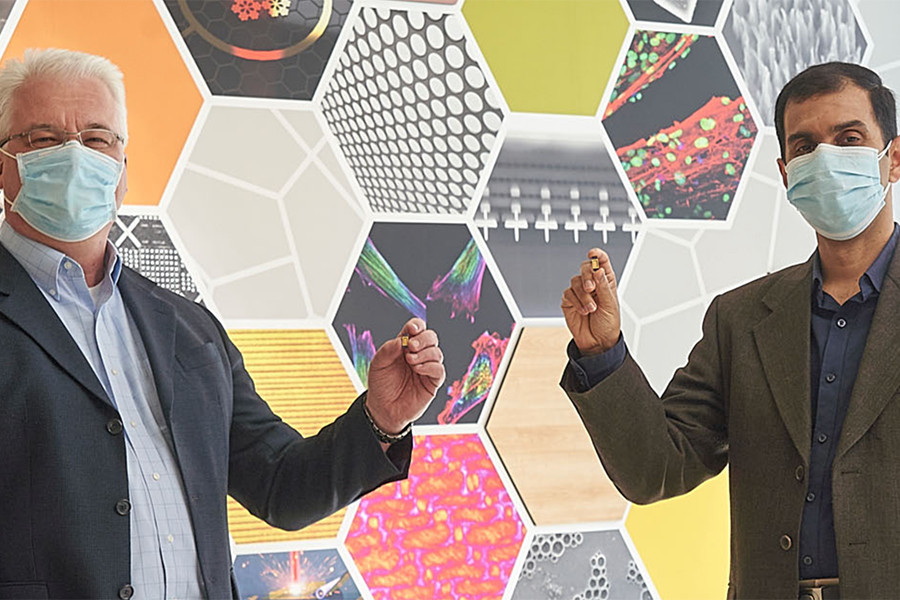

Center for Secure Microelectronics Ecosystems launched at Purdue with TSMC, Synopsys.
(Photo credit: Purdue University | Vincent Walter)
10 minutes to read
Banner image: Joerg Appenzeller (left) and Anand Raghunathan, Purdue professors of electrical and computer engineering, serve as co-directors of the Center for Secure Microelectronics Ecosystem (CSME).
Purdue University has launched the Center for Secure Microelectronics Ecosystem (CSME) with support from industry partners and a U.S. Department of Defense (DOD)-funded workforce development program.
CSME is a first-of-its-kind global partnership of academia, industry and government to advance research and workforce development in designing secure microelectronics. Its aim is to help ensure a secure supply of semiconductor chips and related products and tools, from the foundry to the packaged system, based on a zero-trust model.
Microelectronics underpin every U.S. defense system, and they are fundamental to global commercial technologies, such as 5G, autonomous transportation, drones, the Internet of Things (IoT), artificial intelligence, advanced manufacturing, and more. However, there are increasing vulnerabilities at every level of the global electronics supply chain, and a secure supply of microelectronics is critical to U.S. national security and economic prosperity.
Taiwan Semiconductor Manufacturing Co. (TSMC), one of the world’s largest semiconductor contract manufacturers, is an industry partner.
Purdue has secured funding for the consortium from TSMC and Synopsys, Inc., and through collaboration with the DOD-supported Scalable Asymmetric Lifecycle Engagement (SCALE) microelectronics workforce development program.
Synopsys, a U.S.-based global leader in electronic design automation (EDA) and semiconductor intellectual property, is the consortium’s founding EDA member. The company offers the industry’s broadest portfolio of application security testing tools and services.
CSME provides advanced training opportunities to SCALE participants, while SCALE supports CSME through graduate traineeships, addressing the urgent need for engineering graduates with microelectronics skills. At Purdue, the SCALE program, directed by Peter Bermel, Elmore Associate Professor of Electrical and Computer Engineering, connects Purdue Engineering faculty with 14 other universities, the DOD, NASA, Department of Energy National Nuclear Security Administration (NNSA) labs, and the defense industry to create a microelectronics workforce focused on meeting national security requirements.
Secure microelectronics is a critical research focus area identified under Purdue’s National Security and Technology Initiative. The initiative is one of five designed to advance the university’s competitive advantage.
Purdue partners with leading global chip designer MediaTek on semiconductor design center.
(Photo credit: Rawpixel)
10 minutes to read
Banner image: A collaboration with MediaTek marks another step in Purdue University’s commitment to meeting the future needs in microelectronics.
By Brian Huchel
Purdue University’s College of Engineering is partnering with MediaTek Inc., a leading global fabless chip designer, to open the company’s first semiconductor chip design center in the Midwest, to be housed on Purdue’s campus.
Mung Chiang, Purdue president-elect, joined Indiana Gov. Eric Holcomb; Bradley B. Chambers, Indiana secretary of commerce; Don Graves, deputy secretary of the U.S. Department of Commerce; and MediaTek leaders in hailing the June 2022 announcement.
The center marks another piece of Purdue’s commitment in addressing society’s increasing semiconductor demands and the needed talent pool. In May 2022, the university announced the launch of the nation’s first large-scale, interdisciplinary Semiconductor Degrees Program (SDP), a comprehensive set of innovative, interdisciplinary degrees and credentials in semiconductors and microelectronics. The university also in May announced a partnership with Ivy Tech Community College to provide a variety of collaborative educational opportunities for faculty and students in microelectronics and to explore ways to attract more talent to this area.
In addition, in late July, Purdue announced that SkyWater Technology plans to open a $1.8 billion state-of-the-art semiconductor manufacturing facility in the Discovery Park District at Purdue.
MediaTek and Purdue also will partner on new chip design engineering degree programs, research on artificial intelligence, and communications chip design.
The idea for a new design center for MediaTek was born in 2021, when Gov. Holcomb traveled to Silicon Valley to pitch chip CEOs about Indiana’s commitment to the semiconductor industry. Combined with a follow-up invitation to visit Purdue from university President Mitch Daniels, the Purdue College of Engineering made its case for a first-of its-kind collaboration that included a new design center on campus.
“This means students at Purdue will have the opportunity to interact with world-class chip design talent right across the street,” Chiang said.
Chiang’s team worked with the Indiana Economic Development Corporation (IEDC) to fully leverage Purdue’s role as one of the top engineering schools to attract this new semiconductor investment.
The Purdue partnership represents a new U.S. growth model for MediaTek USA — outside the traditional centers of gravity for chip design.
“We believe strongly that being in Indiana means we’ll have access to some of the best engineering talent in the world,” said Kou-Hung Lawrence Loh, corporate senior vice president of MediaTek Inc. and president of MediaTek USA Inc. “Not just at Purdue, but West Lafayette is only four hours away from nearly a dozen of the top engineering schools in the country. In the post-pandemic world, top candidates tell us they want to be closer to home, near family, and they want to have a real house and great public schools. Indiana offers all that and more.”
MediaTek has been partnering with U.S. universities on advanced research for more than a decade, but this latest project is unique in that a new center will be sited directly on campus and is an opportunity for students to both complete their engineering education and contribute directly to product design and solutions for a global team. The collaboration also will help bring more advanced semiconductor design talent to Indiana.
Purdue launches comprehensive Semiconductor Degrees Program.
10 minutes to read
In the next five years, a minimum of 50,000 trained semiconductor engineers will be needed in the U.S. to meet the overwhelming and rapidly growing demand. Purdue University has answered that call, launching a comprehensive set of innovative, interdisciplinary degrees and credentials in semiconductors and microelectronics.
The nation’s first large-scale, interdisciplinary Semiconductor Degrees Program (SDP) will educate both graduate and undergraduate students, enabling a quick ramp-up of skilled talent and creating the next-generation semiconductor workforce to reassert American preeminence in this critical industry.
Officially launched in May 2022, Purdue SDP touts five distinctive features:


Saab's multimillion-dollar advanced manufacturing facility opens at Purdue.
(Photo credit: Saab)
10 minutes to read
Banner image: Saab Global Defense and Security Co. is contributing to the production of the U.S. Air Force’s T-7A Red Hawk in its new $37 million facility in the Discovery Park District at Purdue.
By Steve Martin
Purdue University’s economic impact on the state of Indiana continues to grow. That’s why Gov. Eric Holcomb and state officials joined those from Purdue in late 2021 to celebrate the grand opening of Saab’s West Lafayette facility.
The multimillion-dollar facility, located in the Discovery Park District at Purdue, supports production of the U.S. Air Force’s next-generation T-7A jet trainer. When at full capacity by 2027, Saab is expected to employ more than 300 people in the West Lafayette facility. The facility, announced in May 2018, opened early last year on the West Lafayette site. However, the COVID-19 pandemic delayed the grand opening.
Saab is part of Purdue’s rapidly growing defense research and technology ecosystem, which includes plans for the first Mach 8 quiet wind tunnel in the world and an expanding Rolls-Royce presence. Within the last couple of years, Schweitzer Engineering Labs (SEL at Purdue) also has built and located within the Discovery Park District at Purdue.
Erik Smith, president and CEO of Saab Inc., said the state-of-the-art facility in West Lafayette is a fundamental part of the company’s strategy to grow its U.S. industrial and technology base. “This facility brings us closer to our U.S. customers and deepens our relationship with them,” Smith said. “We also see there are great opportunities for innovative research through our partnership with Purdue University.”
Indiana partners in the project include the cities of West Lafayette and Lafayette, Tippecanoe County, Greater Lafayette Commerce, and Purdue Research Foundation, all of which offered local and county tax abatements as incentives to bring Saab to the area.
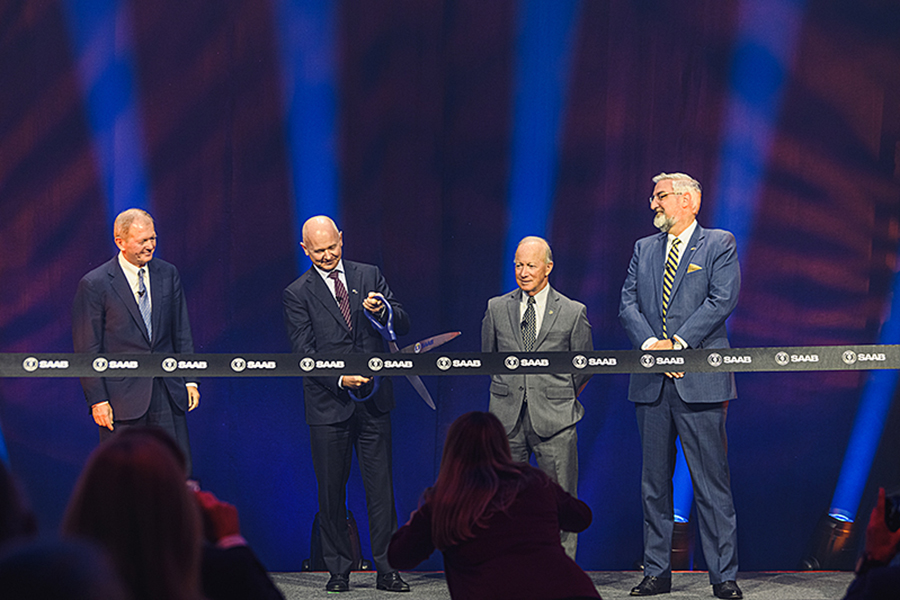


Purdue, Rolls-Royce sign 10-year, $75-million strategic alliance agreement.
(Photo credit: Purdue University | Carson Slabaugh)
10 minutes to read
Banner image: Purdue University and Rolls-Royce officials have signed a research and testing agreement that will bring $75 million over 10 years.
By Steve Martin
Purdue University and Rolls-Royce officials have signed a research and testing agreement that will bring $75 million over 10 years to the West Lafayette campus. It is the largest deal with an industry partner in Purdue history.
The relationship between Purdue and Rolls-Royce has thrived for more than 70 years, highlighted by millions of dollars invested in aerospace testing technology, sponsorship of graduate student research fellowships, and more than 600 Purdue graduates among the company’s current workforce in Indianapolis. Purdue is designated among the top class of partners as a Rolls-Royce University Technology Center, recognizing collaborations on research, including advanced engine technology, materials, and testing capability.
Additionally, the relationship between Rolls-Royce and Purdue recently has expanded to include significant work on initiatives in hypersonics, cybersecurity, and digital technology.
The agreement signed in May 2022 will fund testing and research with a focus in the areas of gas turbine technology and electrical and digital technology. Rolls-Royce already boasts some of the most efficient and capable power systems in the world across a suite of civil and defense applications. At Purdue’s Maurice J. Zucrow Laboratories, research will be concentrated primarily on sustainable power systems through advanced technology in electrification, turbines, compressors and combustion with sustainable fuels.
This research partnership announcement is concurrent with news in April 2022 that Purdue will construct a $73-million, 55,000-square-foot, state-of-the-art, high-speed propulsion laboratory for hypersonic technologies in the Discovery Park District at Purdue.
“Purdue has become the epicenter of hypersonic research and testing in the U.S.,” said Mung Chiang, president-elect of Purdue University.
“We are excited across three tracks: first, our own investment for federal and industry projects, such as the wind tunnel and manufacturing facility announced in 2021, and the high-speed propulsion facility in 2022 that Rolls-Royce will be able to use; second, the private sector’s investment to grow its presence in the Discovery Park District at Purdue; and third, a nonprofit consortium of industry members for ground testing hosted at Purdue.”
Warren White, Rolls-Royce head of assembly and testing, said: “We’re excited to further strengthen our long-standing partnership with Purdue University through this new test and research agreement. We firmly believe in the innovative power that comes from strong collaboration between industry and academia. Over the next decade, we’ll explore transformative technologies like hybrid-electric and hypersonic propulsion that will help define the future of aerospace.”


Rolls Royce enhanced partnership further expands test facilities at Purdue.
(Photo credit: American Structurepoint)
10 minutes to read
Banner image: Rolls-Royce, Purdue University and Purdue Research Foundation are investing to further expand Rolls-Royce’s facilities in the Purdue Aerospace District.
By Steve Martin
Aerospace engine manufacturing giant Rolls-Royce will expand its already large footprint at Purdue, thanks to a new commitment among the university, Purdue Research Foundation and the company.
The enhanced partnership calls for Rolls-Royce to further enlarge its facilities in the Purdue Aerospace District, which is adjacent to the university. The new test facilities will be used to develop high-altitude and hybrid-electric engines to power the next generation of U.S. military aircraft. Rolls-Royce West Lafayette will be developed through a multimillion-dollar investment from the research foundation, Purdue University and Rolls-Royce North America.
The partnership is a major win for the national security and technology pillar of Purdue’s Next Moves. Rolls- Royce already has facilities focusing on digital engine controls and conducts advanced technology engine research at Purdue’s Maurice J. Zucrow Laboratories in the district. It’s part of a long-standing partnership between the company and university spanning several decades of conducting aerospace research. The company also employs hundreds of Purdue engineers.
The facility will enable Rolls-Royce North America to continue its legacy of providing full-service advanced design, development, production and aftermarket support of world-leading propulsion solutions.
Mung Chiang, Purdue’s president-elect, said testing to be conducted by Rolls-Royce will substantially advance national security.
“It represents the largest single economic development success to our neighborhood with Rolls-Royce colleagues and the largest research collaboration with a private sector partner,” he said. “It also advances the excellence at scale by Purdue in creating the epicenter of aerospace engineering R&D in the U.S.”
Brian Edelman, Purdue Research Foundation president, said the investment to expand Rolls- Royce’s presence in the Purdue Aerospace District is a strategic one that will make the vision become a reality. He commented, “The generous support from Lafayette, Greater Lafayette Commerce, West Lafayette and Tippecanoe County provides another example of the strong ecosystem we are building with community, university and corporate partners.”
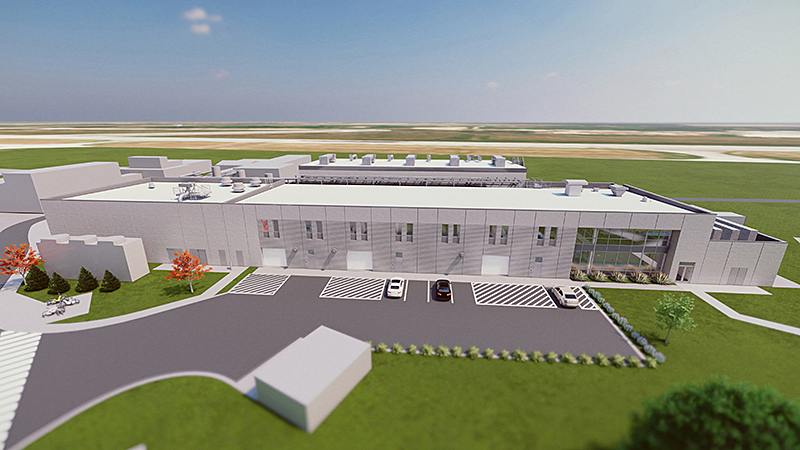

Purdue strengthens national security focus with new propulsion lab
Planned facility offers testing conditions for hypersonics, combustion.
(Illustration credit: American Structurepoint)
10 minutes to read
Banner image: A rendering of the planned High-Speed Propulsion Laboratory in the Discovery Park District at Purdue
By Brian Huchel
Purdue University’s work in national security took another giant leap forward with university trustees’ approval of a state-of-the-art high-speed propulsion laboratory, putting the university’s hypersonic testing capabilities on scale with those of large industry partners.
Hypersonic defense abilities are considered game-changing technologies. With systems that can travel at speeds of Mach 5 or faster and are highly maneuverable, hypersonics are potentially very effective against heavily defended areas.
The High-Speed Propulsion Laboratory, approved in April 2022, will be located in the Discovery Park District at Purdue. The new lab will provide testing capabilities at the extreme pressure and temperature conditions experienced in actual hypersonic flight, significantly enhancing Purdue’s research and development capabilities.
The lab will feature new testing capabilities for innovative research in rocket combustion and gas turbine engines, continuing Purdue’s history of research and development in those areas.
Once the $73 million lab is complete, Purdue will be the only university in the nation with such a high level of propulsion capabilities, providing the capacity to perform propulsion testing reaching a scale only found in government or large defense contractor facilities. The High-Speed Propulsion Laboratory, unlike similarly equipped government or industry facilities, will be available to a very broad set of researchers interested in working with Purdue to test their equipment.
The lab will work in concert with Purdue’s rapidly advancing expansion in hypersonics. The lab proposal included a high-pressure air plant, which will upgrade existing equipment and support all of Purdue’s hypersonic and propulsion testing capabilities. Substantial completion of the lab is expected in November 2024.
The new lab will enable testing for the Hypersonics Advanced Manufacturing Technology Center (HAMTC), which was announced in February 2022. It will also complement testing that will take place within the Hypersonics and Applied Research Facility (HARF), which broke ground in late 2021 in the Discovery Park District at Purdue. HARF will house the first Mach 8 quiet wind tunnel in the world and the Hypersonic Pulse (HYPULSE) reflected shock/expansion tunnel. The Mach 8 tunnel simulates velocity but does not simulate the extreme heat conditions, while the HYPULSE tunnel simulates the extreme conditions of temperature and pressure for a few milliseconds.
In addition to increasing testing capabilities, the new high-speed laboratory will provide opportunities to engage the talents of more graduate students. As many as 80 additional graduate students will be needed to perform the work this new lab affords.

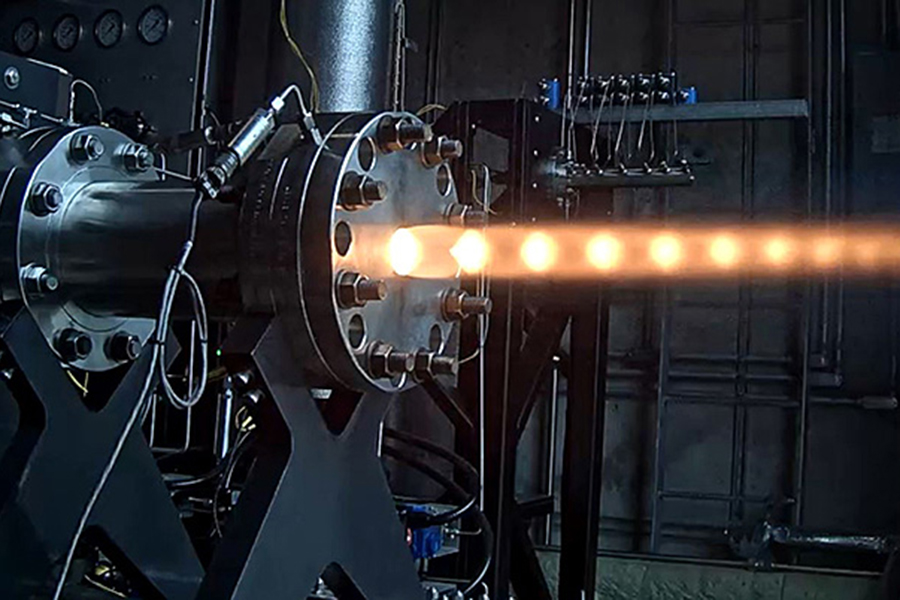



Purdue's new Institute of Hard AI connects AI with the physical world.
(Photo credit: rybindmitriy/stock.adobe.com)
10 minutes to read
Banner image: Purdue’s College of Engineering has launched the Institute of Hard AI, establishing Purdue as a national leader in artificial intelligence at the interface of the virtual and physical worlds.
By Brian Huchel
Purdue’s College of Engineering announced the formation of the Institute of Hard AI in June 2022 during the 11th annual meeting of the National Academy of Inventors in Phoenix. The college-wide institute positions Purdue as a national leader in artificial intelligence at the interface of the virtual and physical worlds.
To understand the term “hard AI,” think of it as bytes meet atoms. The full power of AI is at the interface between what we code and what we touch.
Intended to become a national leader at this frontier and guided by a top-tier alumni advisory board, the institute will combine research, teaching and commercialization in three areas:
AI BY HARDWARE: Future AI applications will place unprecedented demands on computing platforms, requiring advances in function-specific AI hardware to control complex systems and interconnected processes. Autonomous and connected systems, energy generation/distribution, healthcare and smart agriculture are examples of systems that will require specially designed AI chips. Leveraging Purdue’s unique strength in cognitive computing, the Institute of Hard AI will focus on a unique algorithm-to-hardware codesign approach, addressing challenges at all levels: algorithms, system architecture, circuits and devices.
AI OF HARD STUFF: The location for AI is increasingly dispersed through edge computing, where computation, communication and control all move closer to the end users and are dispersed in a distributed, variable, highly constrained and underorganized computing substrate. This brings new challenges to the design of AI systems, including hardware heterogeneity, robustness and the need for extreme energy efficiency. Purdue has some of the world’s leading experts in edge computing, remote sensing and 5G systems. AI doesn’t just live in the cloud — it will be all around us.
AI FOR PHYSICAL THINGS: When AI is used for decisions at the interface of virtual-physical worlds, the criteria for success change. For example, responsiveness and safety matter no less than accuracy and throughput. From autonomous trucks to pharmaceutical manufacturing, from nuclear reactor operation to connected things in digital agriculture, Purdue leads the nation anytime applications touch physical things.
Kaushik Roy, the Edward G. Tiedemann Jr. Distinguished Professor of Electrical and Computer Engineering, will serve as director of the institute. An alumni advisory board is comprised of luminaries from industry, including Chris Lister (BSIE ’95), Mike Harris (BSCEE ’91), Dan Rosckes (BSIE ’84) and Ujjwal Singh (BS Computer Science ’94 and BSEE ’94).
The institute’s initiatives include cutting-edge research and innovation; courses related to hard AI for both industry and academia, including a minor degree in AI for physical applications; a distinguished lecture series; industry partnerships; student-industry networking and career development; and technology commercialization. The effort will also grow to include multiple other departments and colleges on the Purdue campus.
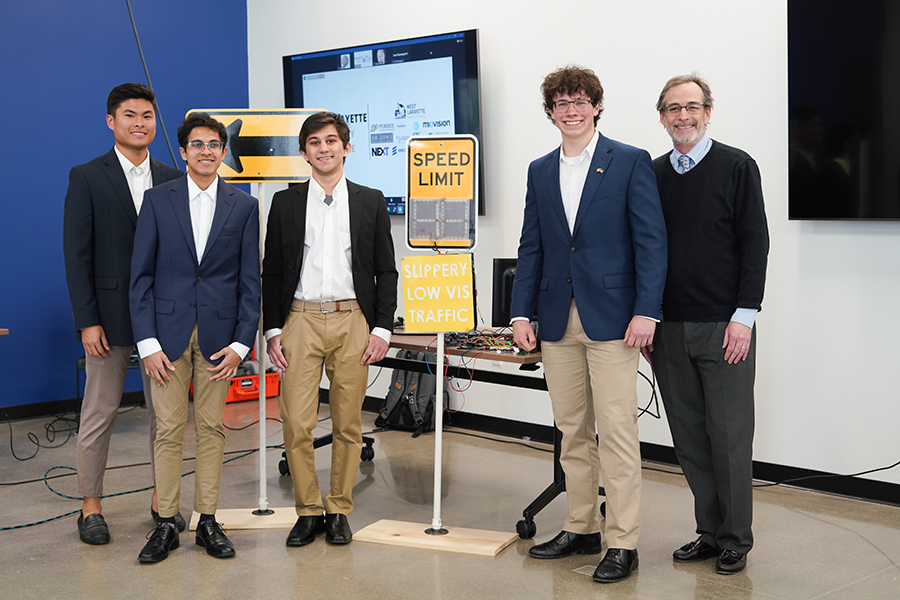

TRAWS
Purdue freshman team earns top prize in West Lafayette Smart City Challenge.
10 minutes to read
Four Purdue College of Engineering first-year students took the grand prize as Team TRAWS in the West Lafayette Smart City Challenge — a $10,000 award and the opportunity to pilot their innovative solution in West Lafayette. The competition called on startups and student teams to develop a scalable Internet of Things (IoT) solution or software application to improve safety for vulnerable road users during high-traffic periods.
Team TRAWS — or Traffic Real-time Analysis Weather System — was advised by Sean Brophy, Purdue associate professor of engineering education. It was led by students Sid Gaur (from Reno, Nevada); Atharva Rao (from Phoenix); Benjamin John Leith Murray (from Apex, North Carolina); and Joachim Tobias Velasco Bautista (from Binan, Philippines).
After advancing to the third and final phase of the competition, TRAWS earned the unique opportunity to run a six-month pilot in the Discovery Park District at Purdue. All four students also secured a one-year membership in the NineTwelve Convergence Lab. TRAWS’ solution emerged as the most scalable and promising idea that could help reduce traffic accidents and injuries. Their solution involves using a sensor array to detect and analyze roadway and pathway activity and congestion, and then to provide information back to roadway users through “smart” road signs to raise awareness of specific safety and congestion situations.
“Based on the ingenuity and engineering spirit we have seen so far from these outstanding Purdue students, we’re excited to see how TRAWS executes their solution during the next phase in a real-world deployment,” said Troy Hege, vice president of innovation and technology at Purdue Research Foundation. “We think the concepts of a broadly deployed smart road sign platform have a lot of potential, so we are interested to see where this goes.”
The viability and potential impact of TRAWS’ solution convinced the Challenge Committee during the West Lafayette Smart City Challenge Demo Day, where TRAWS demonstrated its prototype. The Challenge Committee included subject matter experts from technology companies, who also served as mentors for the three finalist teams during the prototyping phase.

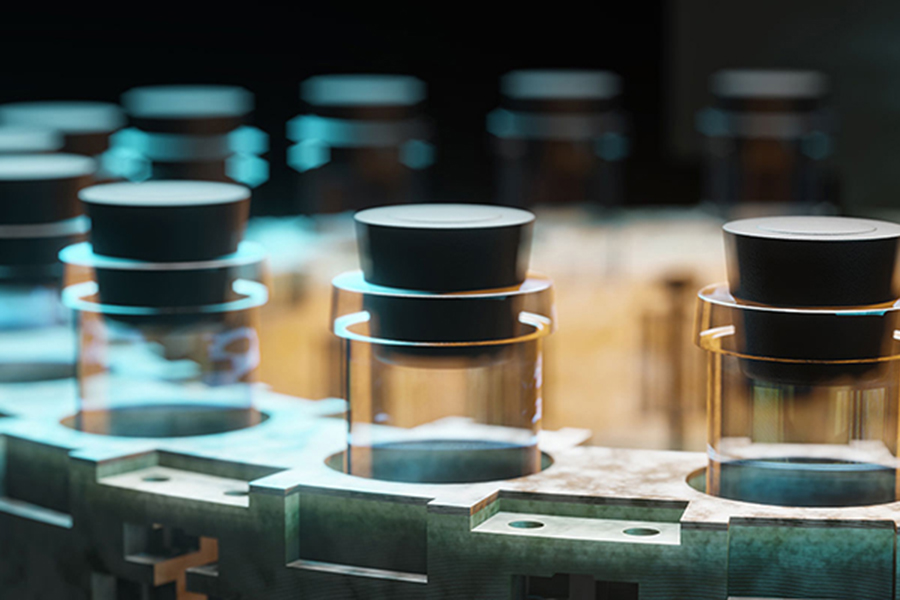

Gift to Purdue University establishes Institute for Advanced Manufacturing of Pharmaceuticals.
10 minutes to read
A generous donation from William D. Young, a pioneer in pharmaceutical and biotechnology manufacturing, will establish the William D. Young Institute for Advanced Manufacturing of Pharmaceuticals at Purdue University. The institute will unite faculty in overhauling pharmaceutical manufacturing with a goal of reducing costs and expanding access to innovative drugs emerging from biotechnology research.
The effort grows from a recognition that pharmaceutical companies have not invested as heavily in economical methods of manufacturing drugs as they have in drug discovery, combined with the unique position of the state of Indiana and Purdue to strengthen pharmaceutical manufacturing in the Midwest.
Total funding dedicated to pharmaceutical and biopharmaceutical research at Purdue is estimated at more than $19 million in 2021. Over 4,000 undergraduate degrees are awarded annually, and more than 2,000 doctoral students are enrolled in disciplines related to pharmaceuticals and biotechnology.
Purdue is among the top 10 organizations when ranked by publications and patents on pharmaceutical manufacturing, according to the 2021 U.S. Industry & Market report (NAICS 324512), published by Barnes Report. Indiana is among the top 10 states in the U.S. for pharmaceutical and medicine manufacturing output, according to the 2018 and 2019 Census Bureau’s Annual Survey of Manufacturers. The state was ranked second in the nation for worldwide life sciences exports, totaling more than $11 billion annually in 2020.
Although the institute is established with the aid of the gift, co-directors Alina Alexeenko, professor of aeronautics and astronautics and associate dean for undergraduate education; Eric Munson, head of the Department of Industrial and Physical Pharmacy in the College of Pharmacy; and Garth Simpson, professor of analytical and physical chemistry in the Department of Chemistry, said it began with a grassroots effort among a consortium of interested faculty members working toward a common goal in pharmaceutical manufacturing. The three co-directors represent 30 founding faculty members from the colleges of Engineering, Pharmacy and Science.
Among the areas of expertise represented by founding faculty members are continuous manufacturing for synthesis of active pharmaceutical ingredient as well as drug product, 3D printing of pharmaceuticals, lyophilization, machine learning to aid in optimization, and an analytical chemistry program that is ranked first in the nation by U.S. News & World Report.
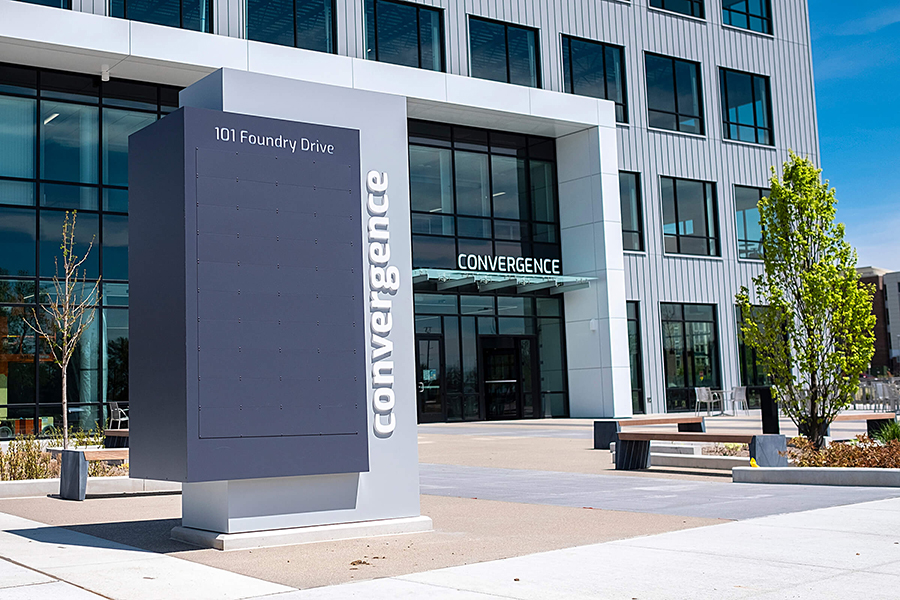

Bayer to open space to apply interdisciplinary approach to build solutions, source innovation.
(Image credit: Purdue Research Foundation | Oren Darling)
10 minutes to read
Banner image: Purdue has announced that Bayer, a global life sciences company, intends to open Bayer at Convergence in the Discovery Park District at Purdue.
Bayer, a global life sciences company, announced in June 2020 that it intends to open Bayer at Convergence in the Discovery Park District at Purdue. When fully staffed, the Bayer space in the Convergence Center for Innovation and Collaboration will employ students who will enhance and augment a robust agricultural innovation portfolio with such additional enabling capabilities as information technology, data science, and engineering.
Students will focus on cutting-edge, real-world and social scientific challenges in areas like advanced analytics, operations research, phenomics, genomics, plant science, and precision breeding technologies.
The Bayer space will employ students who are studying various disciplines, including agriculture, electrical engineering, user experience design, mechanical engineering, software engineering, and imaging sensor science.
Bayer at Convergence will use digital tools and data to drive agricultural innovations, which can increase the efficiency and reduce the amount of water, land and energy necessary to meet the world’s food, fuel and fiber needs.
“As a life science company, we strive to live up to our vision ‘Health for all, Hunger for none.’ Through agricultural innovations, we can help provide farmers improved tools and solutions to sustain our growing world,” said Mike Graham, head of Bayer’s Breeding, Crop Science Division. “We are excited to become members of the Purdue University campus and enhance our efforts in agricultural innovation.”
With the new space, Bayer intends to partner with Purdue faculty and researchers from across campus, representing different colleges and multiple disciplines. Bayer is focused on fostering a collaborative, entrepreneurial and solution-based framework in which students will engage with innovative projects designed to enable novel innovation in crop sciences and agriculture.
Bayer named Susana Díaz-Amaya, a Purdue alumna, to lead the new Bayer at Convergence space.
The $1 billion-plus Discovery Park District at Purdue is a Purdue Research Foundation entity adjacent to the Purdue campus and is a transformational center of innovation.


Purdue, PRF launch 'Lab To Life' 6G digital innovation in Discovery Park District at Purdue.
10 minutes to read
Purdue Research Foundation (PRF) and Purdue University have launched “Lab To Life” (L2L), a real-world test bed that is attracting leading companies wanting to explore the potential of the Discovery Park District at Purdue. L2L is the next step in creating one of the most connected innovation communities in the nation through the evolution from 5G to 6G.
“6G will go from a domain to a foundation to many vertical domains, from one network to a heterogeneous network of networks. From dynamic sharing and new spectra to edge intelligence and open architecture, 6G research needs to be accelerated through deployment in the U.S.,” said Mung Chiang, Purdue’s president-elect. “This group of prominent industry partners and their leaders will turn the Discovery Park District at Purdue into the country’s first at-scale 6G deployment zone, and, along with other essential elements like learning and the arts, create a work-live-play connected community.”
L2L leverages the unique governance structure and open, neutral-host technology infrastructure being deployed across the entire 400-plus acres of the district to advance the development of next-generation wireless networks and digital applications.
A partnership was created with neutral-host infrastructure provider Tilson to deploy more than 15 miles of high-capacity fiber, emanating from an edge data center, and with SBA Communications for deployment of private CBRS networks throughout the district. Over the next decade, this community infrastructure will provide products and services to the approximately 20,000 people who will live, work, learn and visit in the district.
David Broecker, chief innovation and collaboration officer at PRF, said, “We want to create an innovation community with a set of capabilities and assets to advance digital solutions in collaboration with leading technology companies and industrial partners.”
Troy Hege, vice president for innovation and technology at PRF, agreed, saying, “The combination of being adjacent to the Purdue campus and advancing innovation leveraging the district’s infrastructure platform provides the perfect environment for testing and evaluating next-generation technology solutions.”

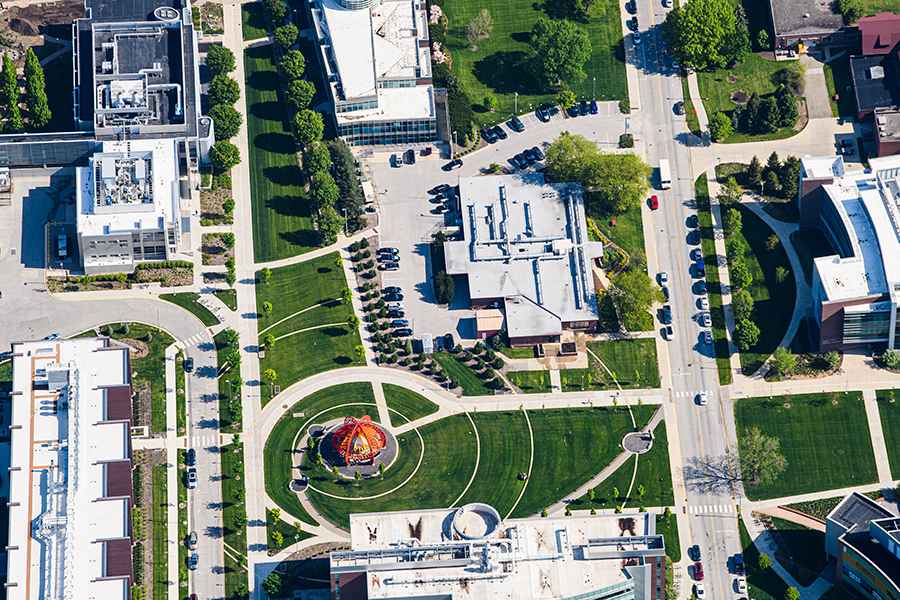

Wabash partnership with Purdue aimed at digital transformation.
(Image provided.)
10 minutes to read
Banner image: Wabash National Corp., now known as Wabash, is collaborating with Purdue to expand with a new space in the Discovery Park District at Purdue.
The business of manufacturing, logistics and transportation, like a lot of businesses, is undergoing a data-driven digital transformation, and Wabash, an innovation leader for engineered solutions in those fields, intends to stay ahead of the curve.
Wabash, formerly Wabash National, and Purdue last year announced a five-year research and development partnership that could apply cutting-edge knowledge in areas ranging from advanced engineering and quantum computing to materials science and electric vehicles to challenges facing the company and its customers — among them the exploding growth of e-commerce and home delivery, and a growing emphasis on sustainability and automation.
They will open a 2,000-square-foot space in the Convergence Center for Innovation and Collaboration.
“We are excited to expand our partnership with Purdue by opening this new space to enrich our collaboration with students, faculty and other Discovery Park businesses,” said Dave Teeter, senior director of talent and organizational effectiveness for Wabash. “Purdue offers extraordinary talent that will help us continue to grow here in Greater Lafayette. We will use this new space on campus to engage with the Purdue community on co-sponsored projects, student outreach, career development, research and innovation.”
Wabash joins a growing list of businesses and organizations opening spaces in the Discovery Park District at Purdue, which also will be home to novel 5G and 6G technologies. The district is a 400-acre launchpad where businesses of all sizes can access a business-minded university, global talent pipelines, and advanced research and development facilities to solve business problems.

Introduction